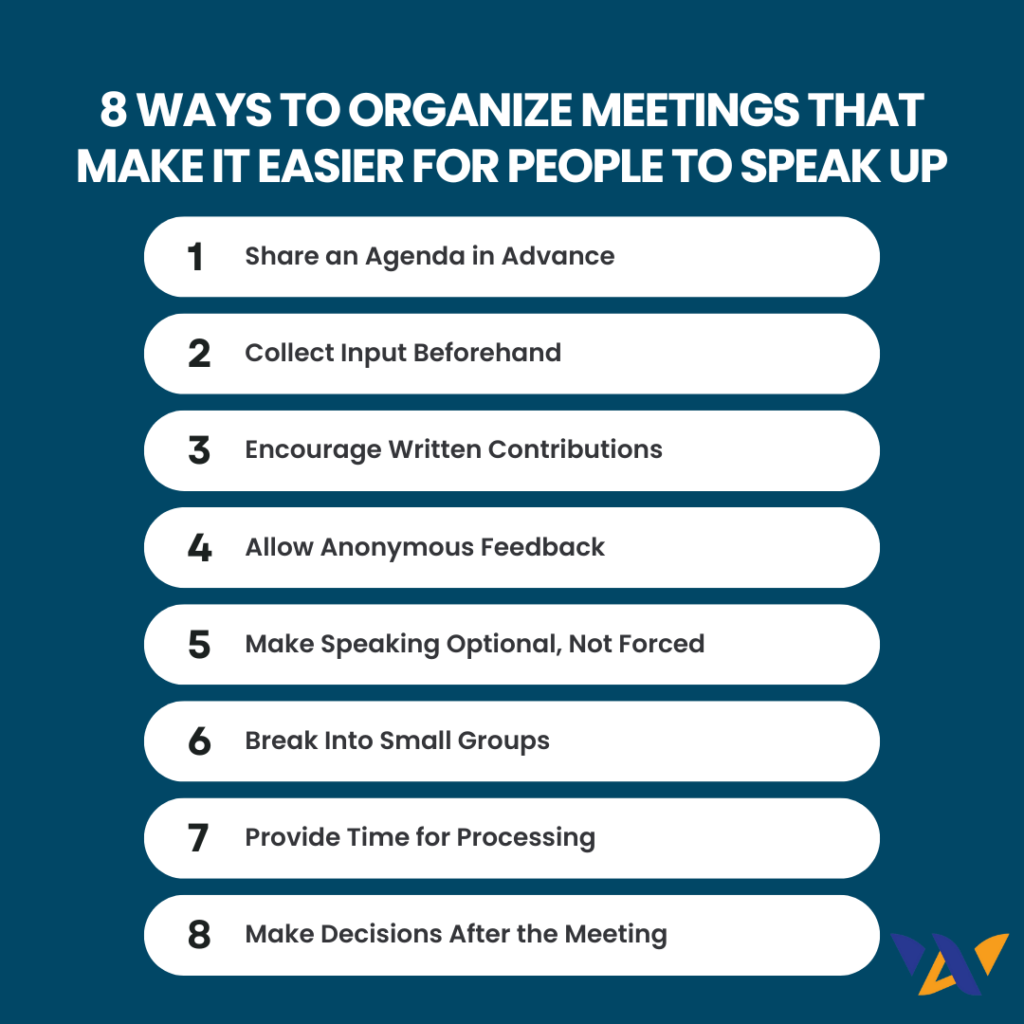Meetings are a crucial part of leadership, yet they often leave many voices unheard. Some employees hesitate to speak up because they feel unprepared, worry about being judged, or simply don’t think their input is valued.
As a leader, it’s your responsibility to create an environment where all team members feel comfortable contributing, not just the most vocal ones. When meetings are designed with inclusivity in mind, you tap into a wider range of ideas, strengthen team collaboration, and make better decisions.
If you’ve ever noticed the same voices dominating discussions while others remain silent, these eight strategies can help you run meetings that encourage everyone to speak up.
8 Ways to Organize Meetings That Make It Easier for People to Speak Up

1. Share an Agenda in Advance
One of the biggest reasons people stay quiet in meetings is feeling unprepared. When employees know what will be discussed ahead of time, they have time to gather their thoughts, formulate ideas, and prepare meaningful contributions.
How to implement it:
- Send the agenda at least 24 hours before the meeting so people can review it.
- Clearly outline discussion topics and decisions that need to be made.
- Highlight where input is needed so employees know how they can contribute.
2. Collect Input Beforehand
Not everyone processes information in real-time. Some employees may need time to reflect before offering an idea or perspective. By gathering input ahead of the meeting, you ensure that diverse viewpoints are considered.
How to implement it:
- Send a pre-meeting survey or Slack message asking for input on key topics.
- Encourage employees to submit questions or ideas anonymously if they prefer.
- Use this input to guide discussions and highlight insights from quieter team members.
3. Encourage Written Contributions
Speaking up isn’t the only way to participate. Some people express themselves better in writing, and offering alternative ways to contribute ensures that you hear from everyone, not just the loudest voices.
How to implement it:
- Allow employees to submit questions or ideas via email or chat.
- Use digital collaboration tools (such as Miro or Google Docs) where team members can add comments before, during, or after the meeting.
- Read out written contributions during the meeting so they are included in the discussion.
4. Allow Anonymous Feedback
Some employees hesitate to speak up because they fear judgment or disagreeing with leadership. Creating a way for anonymous contributions allows people to share their perspectives freely.
How to implement it:
- Use tools like Google Forms or suggestion boxes to collect anonymous feedback before meetings.
- Let employees submit questions or concerns anonymously and address them during the meeting.
- Emphasize that all input is valuable, whether it’s anonymous or shared openly.
5. Make Speaking Optional, Not Forced
Forcing people to speak up can have the opposite effect—it can make meetings feel like a test rather than a discussion. Instead, focus on creating a space where speaking up feels natural, not mandatory.
How to implement it:
- Avoid putting individuals on the spot. Instead, open the floor by saying, “Does anyone have insights to share?”
- Recognize non-verbal contributions, such as nodding or engaging in chat discussions.
- Let employees know they can share ideas later via email or in follow-up meetings.
6. Break Into Small Groups
Large meetings can feel intimidating, especially for introverts or newer team members. Smaller group discussions encourage deeper conversations and make it easier for everyone to contribute.
How to implement it:
- Use breakout rooms in virtual meetings or divide participants into small groups during in-person discussions.
- Assign a facilitator to guide each group’s conversation and report key takeaways.
- Rotate groups so employees interact with different colleagues, making discussions more dynamic.
7. Provide Time for Processing
Pauses and moments of silence in meetings aren’t awkward—they’re necessary. Some employees need extra time to gather their thoughts before responding.
How to implement it:
- Instead of expecting immediate answers, give a few moments for reflection before opening the floor to discussion.
- Normalize silence by saying, “Let’s take a moment to think before we continue.”
- Acknowledge that different thinking styles exist and build in time for both quick and reflective contributors.
8. Make Decisions After the Meeting
Not all decisions need to be made on the spot. Some of the best ideas emerge after people have had time to think.
How to implement it:
- Give team members time to reflect and submit additional ideas after the meeting.
- Follow up with an email summarizing key points and inviting further input.
- Schedule follow-up discussions when necessary to ensure all voices are heard before making final decisions.
The Best Meetings Make Space for Every Voice
Running effective meetings isn’t just about covering an agenda—it’s about making sure everyone has the opportunity to contribute in a way that feels comfortable for them.
By implementing these strategies, you can create a meeting culture where:
- Quieter employees feel heard and valued.
- Discussions become more inclusive and diverse.
- Decisions are based on a broader range of insights.
When employees feel safe and encouraged to speak up, you unlock new ideas, strengthen collaboration, and create a more engaged team.
Are You Ready to Tap Into Your Team’s Full Potential?
If you want to develop a team that leads with confidence, collaborates effectively, and drives results, sign up for Lead with Strengths: A 5-Day Course to Building High-Performing Teams today.
In this course, you’ll learn:
- Uncover hidden strengths on your team
- Map strengths on your teams
- Boost team engagement
- Build a cohesive, high-performing culture
Sign up now and start fostering a culture where everyone feels confident speaking up and contributing their best work.
Join the Lead With Strengths Email Course
Want more introvert leadership tips? Watch related videos for strategies to get noticed at work here!


